At 0900 hrs rented a car from the rental company in Las Galletas with the best single day hire rates we could find (Karibe car rental 922 785 642) for 25 euros per day with full insurance and two drivers. Drove north east along the TF1 motorway to La Laguna, Tenerife's second largest town.
Founded in 1496, La Laguna was the island's capital until 1723 when Santa Cruz became the capital.

The old part of town is full of beautiful old buildings - this one houses the tourist office and has a typical airy central courtyard.

The Town Hall was decorated with embroidered banners



After La Laguna we drove along the north coast on the TF5 with views of Puerto de la Cruz - a misnomer as it is no longer really a port - the few fishing boats that operate from here are always pulled out of the water onto the pebble beach.

and Mount Teide which at an altitude of 3718 meters is visible from many places around the island

Stopped at the new Mirador cafe

which is dedicated to Alexander Humboldt who stopped in Tenerife in 1799 for a few days on his way to Latin America and explored the relationship between plant species and altitude in the Orotava valley

Next stop Orotava, a very well preserved old town. Below is the Iglesia de la Concepcion


Our main reason for visiting Orotava was that work was in progress on the sand tapestry in front of the Town Hall.

Every year artists make a very intricate sand tapestry using over 20 different coloured sands from Mt Teide depicting biblical scenes.





During the Corpus Christi festival, a religious procession walks over this extraordinary work of art, effectively destroying days of skilled work in a matter of minutes. This year, the procession is scheduled for 30 June.



Leaving Orotava, we headed up towards Mt Teide and stopped at the visitor centre. There we were told we were in luck, the normally closed to the public Izafia Astrophysical Observatory complex was having its monthly open day.

We just made it in time for the last tour of the day and were shown around several of the telescope facilities by the very enthousiastic multinational staff.

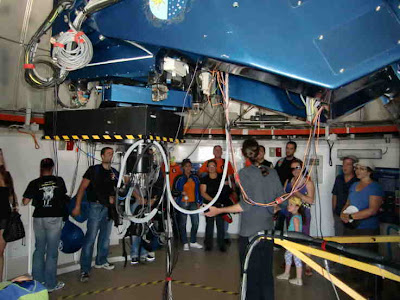


The next building we visited housed the sun observation apparatus

The pyramidical shaped building had an accurate sun dial on one side

The suns rays were collected by a mirror sytem which rotated synchronously with the earth/ sun relative movement such that the sun's radiation was always projected through a hole in the wall to the instruments within he building

The next telescope was run by the UK's Bradford University as a educational aid for schools and anyone interested in astronomy. By visiting their website http://www.telescope.org/ one can see what is being observed in real time.

The telescope is a robotic telesciope which is operated remotely from Bradford in the UK


We then visited this telescope

and were given an explanation by a very enthousiastic researcher.

This telescope is used at the moment for several different purposes. A laser can be connected which is used for testing the possibility of data communication with satellites via light. Another project is to catalogue space debris left in space by the worlds various space programs and which could be a hazard to satellites.

We were then allowed to observe the sun via a refractive telescope


and a reflecting telescope

The very interesting visit ended with a short film on the Northern Lights.
We then continued our trip crossing the moonlike landscape of the Mt Teide Caldera

Our next stop was Adeje where tapestries were also being prepared, this time in the main street of the village ready for the Corpus Christi festival.

Unlike Orotava, the artists were not professionals but were various organisations

and family groups

Instead of Teide's sands, coloured salt seems to be the main medium
 Please click on arrow to start video clip
Please click on arrow to start video clip
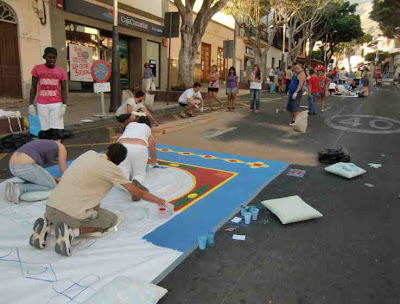
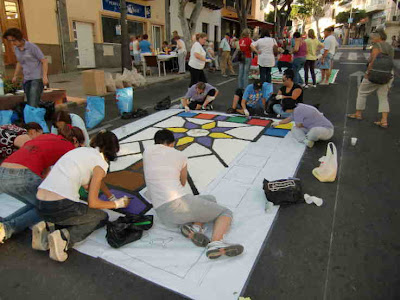

All ages were busy on their knees delicately placing the salt according to the design



Work continued into the night



The Voluntary Fire Brigade were also busy

As were the Police

A nun also gave a helping hand





We had noticed a group carrying kitchen sieves and were wondered why

Then we saw people positioning stencils between the tapestries on top of light coloured sand - the sieves were using to dispense the sand


The stencils were used to put darker coloured sand on top of the light coloured sand


The end result is a simple motief tapestry joining the more elaborate ones so as to make a continuous carpet
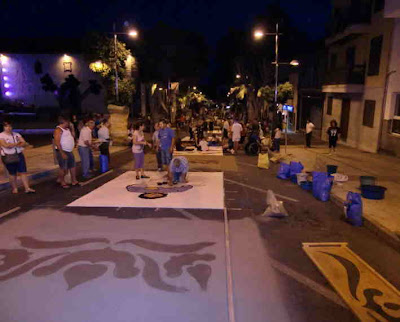
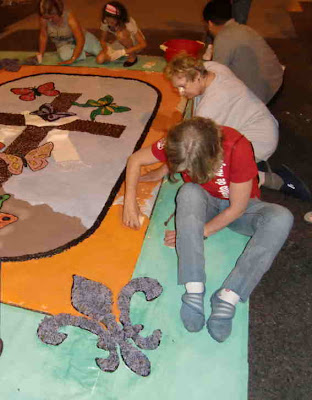


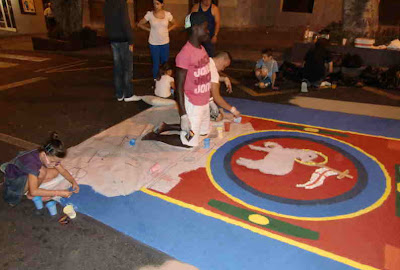

When we left Adeje at 22.30hrs work was still in full swing. The procession which would effectively destroy all their work, would take place the next day.
1 comment:
Nooit geweten dat dit bestond, wat een werk en wat zit dat geloof daar nog diep.Hartelijk dank voor de geweldige foto-reportage , we hebben weer kunnen genieten.Lieve groeten van Loes en Gerard
Post a Comment